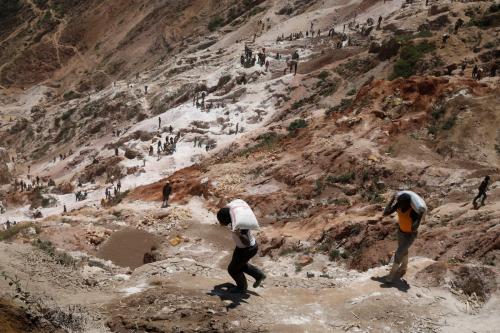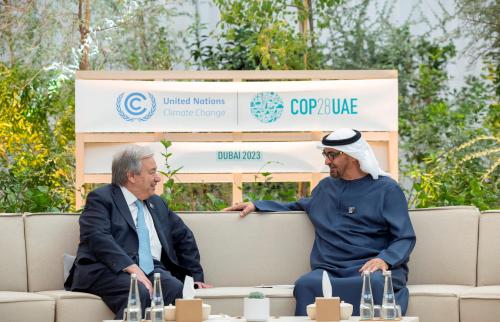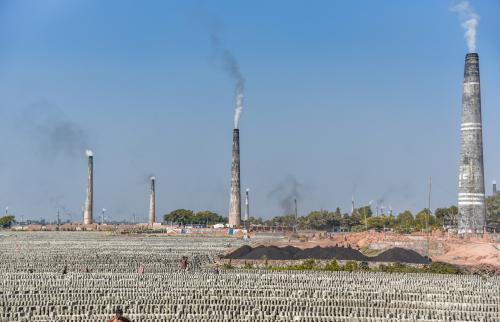On June 25, the Cross-Brookings Initiative on Energy and Climate hosted a discussion on the new dynamics of global energy, featuring International Energy Agency (IEA) Executive Director Fatih Birol, in conversation with Initiative Co-Chair David G. Victor. Among its core themes was, as Birol aptly described, “geopolitics is back to energy.”
In opening, Victor reflected on how the energy “world is now transforming,” adding, “we’re looking at tremendous changes in costs … in the electric power sector—potentially, a complete transformation of the grid,” along with the opportunities and risks this presents.
Transformation in the energy sector is shifting geopolitics
During the discussion, Birol outlined four transformative shifts—“energy upheavals,” he called them—that he viewed as driving the major changes underway in the global energy system:
1China is changing, and moving toward cleaner energy
China is changing the game in global energy markets, especially in clean energy. Due to shifts in its domestic energy consumption and production in recent years, China has grown to become the number one producer of solar and wind energy in the world. Moreover, its choices in the coming decades will greatly influence global trajectories in energy production, and, in greenhouse gas emissions.
2Clean energy is becoming cheaper
Birol observed how some renewable energy sources—particularly wind and solar—are becoming cost-competitive with fossil energy resources, even “becoming the cheapest source of electricity generation in many emerging countries.” Despite remaining challenges with grid integration, Birol remarked, “Renewables are not, anymore, a romantic story.”
3The U.S. energy boom is shifting global energy markets and geopolitics
As IEA analyses predicted several years ago, increases in U.S. oil and gas production are beginning to shift the politics of global energy. Birol explained, “The U.S. is a major producer, a major exporter … and has changed the role of the global energy markets, and, as such, the established role of the traditional exporters [the Organization of Exporting Petroleum Countries, or OPEC] has changed.” Continuing, he added, “The U.S. will be the undisputed leader in oil and gas production for many years,” noting that the “implications will be felt from the trade floors, to the geopolitics of energy.”
4The electrification of the global energy system
Birol described how electricity demand is growing at a rate two times faster than overall energy demand, driven primarily by the expansion of electricity access in emerging economies. In discussing electrification, Birol noted how rising electricity demand in India and China could alter and “lock in” the trajectory of our technological systems for decades to come.
Victor reflected that ripe among the political rhetoric in Washington is the Trump administration’s theme of “energy dominance.” Here, Birol argued, as the United States begins to take on a larger role in energy exports, it could begin to wield its newfound energy abundance as a foreign policy lever.
“Geopolitics is back to energy.”
Victor and Birol also discussed the role of increasing diversification of countries’ energy sectors and economies, and accompanying geopolitical implications. Several countries traditionally heavily reliant on oil and gas revenues to fill their coffers are now seeking energy reforms, as did Mexico. So, too, are countries eager to diversify not only the types of energy they use, but also their sources, to reduce reliance on any single country or grouping of countries.
Changing data Trends
Birol additionally detailed two shifting trends in global energy data:
- Climate change: Following a period of leveling off of global carbon dioxide emissions (one of the major greenhouse gases contributing to climate change) between 2014 and 2016, the following year, global carbon dioxide emissions again began to rise. Birol stressed, “If we want to be on track with our scenarios … [and the temperature goals of the Paris climate agreement], we have to see a peak of the emissions very soon. The idea was 2020s.” Still, he and Victor were pessimistic about this possibility, reflecting on how this window is rapidly closing, particularly as newly committed projects begin to “lock in” future emissions. In Birol’s view, “huge technological breakthroughs or huge political breakthroughs” are needed. Perhaps more optimistic about addressing methane emissions (another potent greenhouse gas) from natural gas, Birol stated, “Half of the emissions from methane—that we can get rid of at no cost—is equal to the emissions of two-thirds of coal plants in Asia.” He also discussed efforts underway at the IEA to explore the role that carbon capture, utilization, and storage (CCUS) technologies could play in mitigating greenhouse gas emissions.
- Energy access: IEA examines global energy access and its distribution about the world. Birol commented on progress made in both China and India in this regard, with China having achieved universal access previously, and India expanded access to all villages as of April 2018. He noted, however, that considerable efforts remain in sub-Saharan Africa, where two out of three people still lack energy access.
“If we want to be on track with our scenarios… [and the temperature goals of the Paris climate agreement], we have to see a peak of the emissions very soon. The idea was 2020s.”
Moving Forward
Birol closed the discussion remarking, “Some of the challenges we have today are so huge, and so immediate—imminent challenges—that if we want to address those challenges, there is a need for a collective public answer. We are not in a position to leave everything to the market. … Together with the private sector, together with the energy industry … I see a leadership role from the public institutions badly needed here.”



Commentary
Fatih Birol and David Victor on the geopolitics of energy
July 2, 2018